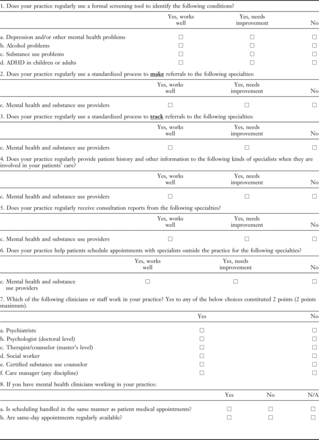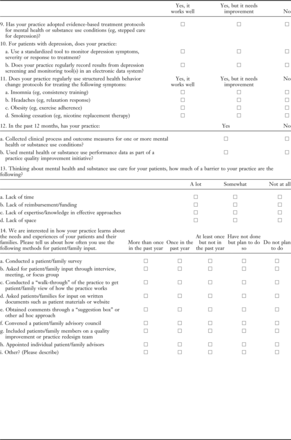Article Figures & Data
Figures
Questions in the Mental Health Organizational Index
Results for Mental Health Clinical Index
Tables
Characteristics Practices (%) <5 Physicians 55 NCQA recognition level 1 or 2 44 3 56 Ownership Physician owned 50 Other 40 >20% of patients with Medicaid or other public insurance or no insurance 33 Practices with more than one location 37 Specialty Internal medicine only 22 Family practice only 40 Pediatrics only 6 Combination 25 Other specialty 6 NCQA, National Committee for Quality Assurance.
- Table 2. Frequency of Behavioral Health Providers in Patient-Centered Medical Home Practices
Behavioral Health Provider Practices (%) Any behavioral health clinician on site 42 Case manager 62 Psychiatrist 16 Psychologist 22 Social Worker 25 Substance abuse clinician 9 - Table 3. Comparison of Referral Processes for Behavioral Health versus Other Medical Subspecialty among Patient-Centered Medical Home practices
Process Practices Reporting That They Have a Standardized Process (%) MH/SA Cardiology P Value (MH/SA vs Cardiology) Endocrinology P Value (MH/SA vs Endocrinology) Processing referrals 84 91 .006 90 .01 Tracking referrals 75 85 .001 83 .003 Providing patient history and other information to specialists 83 96 .0006 96 .0006 Receiving consultation reports from specialists 77 96 <.0001 96 .0001 Helping patients schedule appointments with specialists outside the practice 78 87 .04 84 .24 MH/SA, mental health/substance abuse.
Organizational Items Practices Reporting Each Organizational Item (%) Yes, Works Well Yes, Needs Improvement No Use of formal screening tool for: Depression and/or other mental health problems 46 34 20 Alcohol problems 39 32 29 Substance use problems 33 32 36 ADHD in children or adults 34 24 42 Standardized process to make referrals to MH/substance use providers 50 33 16 Standardized process to track referrals to MH/substance use providers 33 41 25 Regularly provide patient history and other information to MH/substance use providers 59 25 16 Regularly receive consultation reports from MH/substance use providers 34 43 23 Help patients schedule outside appointments with MH/substance use providers 41 37 22 Yes (2 points) No (0 points) Has at least one mental health clinician at the practice 42 58 Scheduling of appointments with mental health clinicians at the practice in same manner as medical appointments 36 64 Availability of same-day appointments with a mental health clinician 28 72 Mental Health Organizational Index, mean (SD) 12.3 (5.6) ADHD, attention deficit hyperactivity disorder; MH, mental health; SD, standard deviation.
- Table 5. Reporting on Mental Health Organizational Index and Mental Health Clinical Index By Practice Characteristics
Mental Health Organizational Index Mental Health Clinical Index Mean (SD) P Value (Difference across Categories Mean (SD) P Value (Difference across Categories) Ownership/affiliation .07 .75 Physician owned (n = 61,61) 11.4 (5.5) 7.8 (5.0) Other (n = 49,49) 13.4 (5.9) 7.5 (5.4) Practice size .30 .95 <5 Physicians (n = 66,65) 11.9 (5.3) 7.6 (5.3) ≥5 Physicians (n = 53,51) 12.9 (5.7) 7.5 (5.1) NCQA patient-centered medical home recognition .86 .11 Level 1 or 2 (n = 53,51) 12.2 (5.6) 6.7 (5.8) Level 3 (n = 66,65) 12.4 (5.4) 8.2 (4.6) Insurance mix <.0001 .003 ≤20% of patients with Medicaid or other public insurance or no insurance (n = 63,63) 10.4 (5.4) 6.6 (4.7) >20% of patients with Medicaid or other public insurance or no insurance (n = 41,41) 14.9 (5.4) 9.7 (5.4) NCQA, National Committee for Quality Assurance.
- Table 6. Obstacles That Limit Mental Health, Substance Abuse, and Health Behavior Implementation Somewhat or a Lot
Obstacles Practices (%) Lack of time 92 Lack of reimbursement 91 Lack of expertise 74 Lack of space 51











